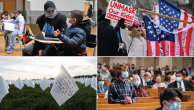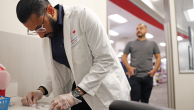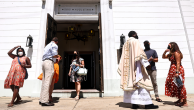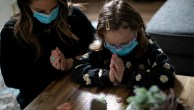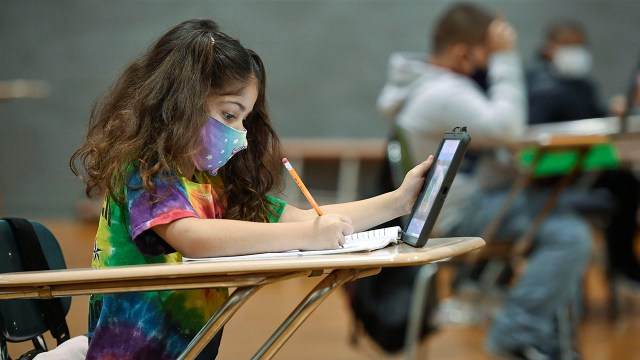
Pew Research Center conducted this study to understand how Americans are continuing to respond to the coronavirus outbreak. For this analysis, we surveyed 10,282 U.S. adults from May 2 to 8, 2022.
Everyone who took part in the survey is a member of the Center’s American Trends Panel (ATP), an online survey panel that is recruited through national, random sampling of residential addresses. This way, nearly all U.S. adults have a chance of selection. The survey is weighted to be representative of the U.S. adult population by gender, race, ethnicity, partisan affiliation, education and other categories. Read more about the ATP’s methodology.
Here are the questions used for this report, along with responses, and its methodology.
As levels of public concern over the coronavirus outbreak recede, Americans offer a lackluster evaluation of how the country has balanced priorities during the outbreak. A majority of U.S. adults say the country has given too little priority to meeting the educational needs of K-12 students since the outbreak first took hold in February 2020. Assessments of the nation’s response across other domains are little better: Fewer than half of Americans say the country has done about the right amount to support quality of life and economic activity or to protect public health.
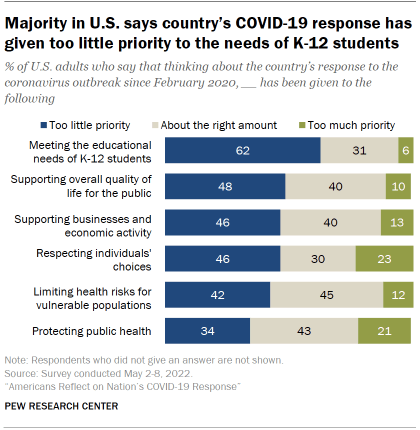
When asked to take stock of what measures have worked to limit the spread of the coronavirus, the public is conflicted. Vaccines and masks rank at the top of the list of effective steps; but even for these public health tools, sizable shares of Americans describe them as no more than somewhat effective at limiting the spread of the coronavirus.
A Pew Research Center survey of 10,282 U.S. adults conducted from May 2 to 8, 2022, finds 62% of Americans say the country has given too little priority to meeting the educational needs of K-12 students during its response to the coronavirus outbreak; far fewer (31%) say this has received about the right amount of priority since the outbreak first began in February of 2020 (just 6% say it’s received too much priority).
On balance, larger shares of Americans also say too little priority – rather than the right amount – has been given to supporting the public’s overall quality of life, supporting businesses and economic activity, and respecting individuals’ choices.
When it comes to the central goal of protecting public health, Americans have decidedly mixed views: 43% say the country has given about the right amount of priority to protecting public health, while 34% say this has received too little priority and 21% say it has received too much.
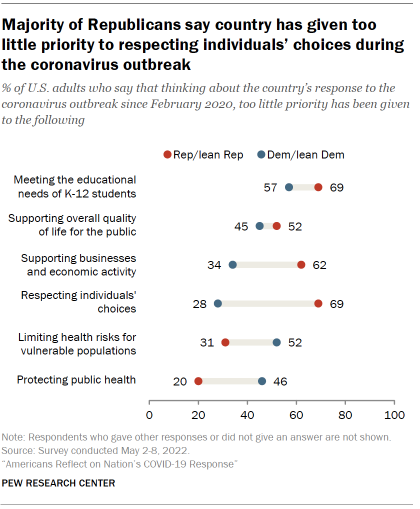
The overall findings reflect two competing critiques of the nation’s response. One, widely expressed among Republicans, is that the country has not focused enough on business concerns and respecting individual choices. The other, more widely held by Democrats, centers concern around efforts to protect public health and limit health risks for vulnerable populations.
In short, neither Republicans nor Democrats think the country has hit the mark in its response to the outbreak – one that has spanned the presidential administrations of both Donald Trump and Joe Biden.
Among Democrats and Democratic-leaning independents, larger shares say protecting public health has received too little priority than say it has received too much (46% vs. 7%), while 46% say it has gotten about the right amount of priority. Republicans and Republican leaners offer a very different assessment: More say public health has received too much priority (40%) than say it’s been given too little (20%), while 38% say it’s gotten about the right amount of priority.
Majorities of Republicans say the country has done too little during the outbreak when it comes to respecting individuals’ choices (69%) and supporting businesses and economic activity (62%). Relatively small shares of Democrats express these views. In fact, half of Democrats say there has been about the right amount of attention given to supporting businesses and economic activity. And Democrats are roughly as likely to say too much priority has been given to respecting individuals’ choices as to say too little (33% and 28%, respectively). See the Appendix for more details on this question.
Amid these contrasting views of the nation’s response to the coronavirus outbreak stands a notable point of general partisan agreement: Majorities of both Republicans (69%) and Democrats (57%) say the country has given too little priority to meeting the educational needs of K-12 students. A January survey by the Center found a majority of parents of K-12 students expressed concern about academic progress when it came to decisions about whether to keep schools open for in-person instruction.
Over the past two years, public health and elected officials have invested extensively in communicating ways to limit the spread of the coronavirus. For Americans, vaccines rank at the top of the list of what they believe has worked, followed by mask-wearing and limiting interactions with other people. Still, not all Americans see these measures as particularly effective.
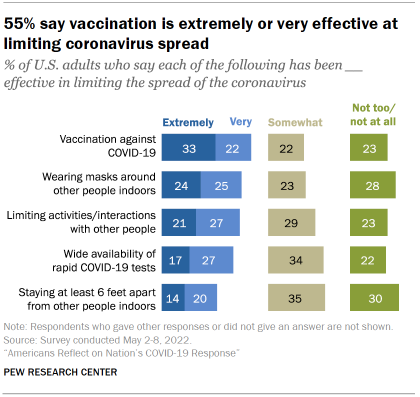
For instance, a narrow majority (55%) says vaccination against COVID-19 has been extremely or very effective at limiting the spread of the coronavirus; 22% say this has been somewhat effective and 23% say it has been not too or not at all effective.
About half say wearing masks around people indoors (48%) and limiting activities and interactions with other people (47%) have been extremely or very effective at limiting the spread of the coronavirus. The remainder of Americans describe these two steps as no more than somewhat effective.
The partisan gaps over the effectiveness of these interventions are about as wide as any seen in the survey. For instance, 75% of Democrats say COVID-19 vaccines have been extremely or very effective at limiting the spread of the coronavirus; 16% say they have been somewhat effective and just 9% describe them as not too or not at all effective.
Republicans offer a much more skeptical view: A slightly larger share of Republicans say vaccines have been not too or not at all effective at limiting the spread of the coronavirus than say they have been extremely or very effective (39% vs. 32%); 29% fall between these two views and say vaccines have been somewhat effective.
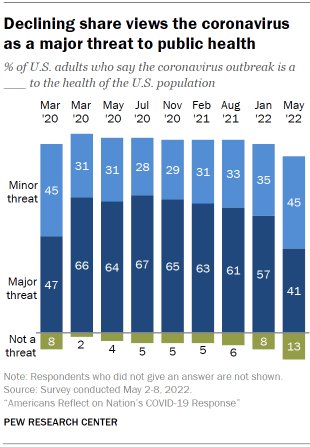
Asked to assess where the country stands at this stage of the outbreak, about three-quarters of Americans (76%) say the worst of the country’s problems from the coronavirus are behind us. And declining shares express deep personal concern about getting the coronavirus themselves.
But while the intensity of public concern about the coronavirus outbreak has waned, cases in the U.S. remain stubbornly high and 86% of Americans say the outbreak remains at least a minor threat to the health of the U.S. population.
To date, over a million Americans have died from COVID-19. Firsthand connections to people who have experienced serious cases of COVID-19 are common among the public: 81% of U.S. adults – including 88% of Black and 86% of Hispanic adults – say they know someone personally who has been hospitalized or died from the coronavirus. See the Appendix for more details.
Ratings of Biden’s, public officials’ response to the coronavirus outbreak
Four months ahead of the November midterm elections, President Joe Biden’s standing on the issue of the coronavirus outbreak has diminished. A majority of adults (56%) say he is doing an only fair or poor job responding to the outbreak, compared with 43% who say he is doing an excellent or good job.
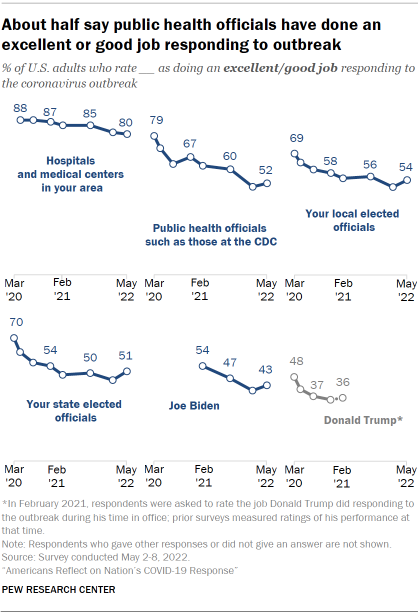
In October of 2020, Biden held a clear advantage over Donald Trump as the candidate voters saw as better able to handle the public health impact of the outbreak – among the issues voters identified as most important to the election. And at the start of Biden’s term, 65% of Americans said they were confident in his ability to deal with the outbreak.
Biden is not the only official, or set of officials, to see their ratings fall over the course of the outbreak. Ratings for state and local elected officials as well as for public health officials – such as those at the Centers for Disease Control and Prevention – are all lower today than at early stages of the outbreak, though they are about the same as they were in January of this year.
Ratings for the performance of local hospitals and medical centers stand well above those of other groups. Eight-in-ten Americans say hospitals and medical centers in their area are doing an excellent or good job responding to the coronavirus outbreak – far higher than ratings of all other groups and individuals included in the survey. The gap between ratings for local hospitals and medical centers and those for other groups, including public health and state and local officials, is much wider today than at early stages of the outbreak.
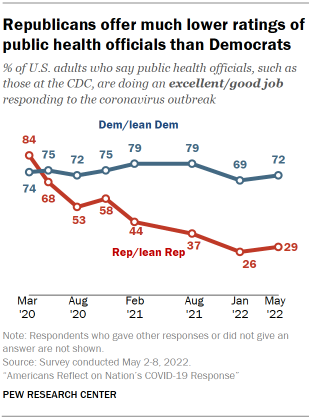
Ratings of public health officials are an example of intensifying partisan differences that have formed over the course of the outbreak. Democrats and those who lean to the Democratic Party are far more likely than Republicans and GOP leaners (72% vs. 29%) to say public health officials, such as those at the CDC, have done an excellent or good job responding to the coronavirus outbreak. In the early stages of the outbreak, majorities of both Republicans and Democrats gave public health officials positive ratings.
While the overall decline in ratings for public health officials has been driven by sharply lower assessments among Republicans, the declines in ratings for state and local elected officials have occurred among both Republicans and Democrats.
National preparedness for a future global health emergency
Asked to consider preparedness for a future global health emergency, 59% of Americans say they have either a great deal (15%) or some confidence (44%) in the U.S. health care system to handle a future global health emergency. Four-in-ten say they have not too much or no confidence at all in the U.S. health care system to handle a future global health emergency.
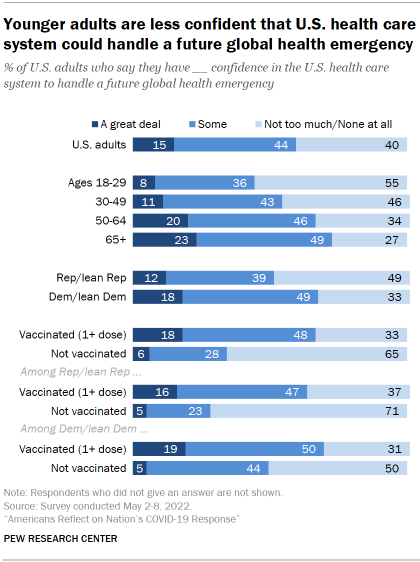
Overall views are similar to those measured in February of 2021, when 55% of Americans said they had at least some confidence in the health care system to handle a future global health emergency.
However, views among partisans have changed considerably over the last year. Democrats are now significantly more likely than Republicans to say they have a great deal of or some confidence in the health care system to handle a future emergency (67% vs. 51%). In February 2021, during the final days of the Trump administration, Republicans (57%) were about as likely as Democrats (54%) to express this level of confidence in the preparedness of the U.S. health care system.
Attitudes also differ on this question by vaccination status. A majority of adults (67%) who have received at least one dose of a COVID-19 vaccine say they have a great deal of or some confidence in the health care system to handle a future emergency, compared with just 34% of those who have not received a vaccine. Republicans and Democrats who have received a vaccine are each more likely to express confidence in the health care system than unvaccinated members of their respective parties.
What measures have worked to limit the spread of COVID-19?
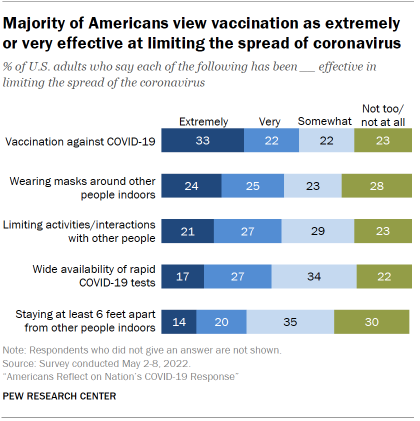
Overall, 55% of Americans say vaccination against COVID-19 has been extremely (33%) or very (22%) effective at limiting the spread of the coronavirus; 22% say vaccines have been somewhat effective and 23% say they have been not too or not at all effective.
About half of Americans (48%) say wearing masks around other people indoors has been extremely or very effective at limiting the spread of the coronavirus. A similar share (47%) say limiting activities and interactions with other people has been extremely or very effective. Still, for both measures, roughly as many Americans describe these actions as no more than somewhat effective at limiting the spread of the coronavirus.
The wide availability of rapid COVID-19 tests is seen as very or extremely effective at limiting the spread of the coronavirus by 43% of the public. Relatively fewer (35%) say staying six feet apart from other people indoors has been extremely or very effective at limiting the spread of the coronavirus.
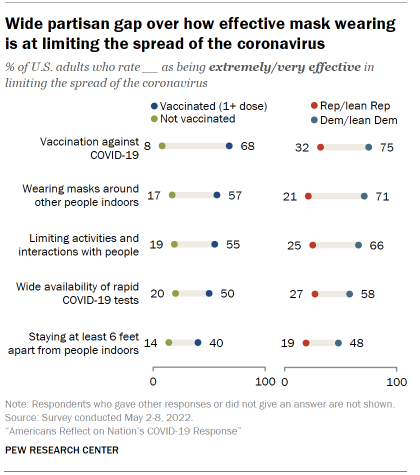
Democrats are much more likely than Republicans to view all five measures as extremely or very effective at limiting the spread of the coronavirus. For instance, 71% of Democrats say wearing masks around other people indoors is extremely or very effective at limiting the spread of the coronavirus; a considerably smaller share of Republicans (21%) say the same.
Across the five public health tools asked about in the survey, wide differences in views are also seen between adults that have received at least one dose of a COVID-19 vaccine and those that have not been vaccinated. Among respondents that have received at least one dose of a vaccine, a majority views several of these measures – vaccines, wearing masks and limiting social interactions – as extremely or very effective at limiting the spread of the coronavirus. Among the much smaller share of Americans who have not been vaccinated, no more than two-in-ten say any of these five measures are extremely or very effective.
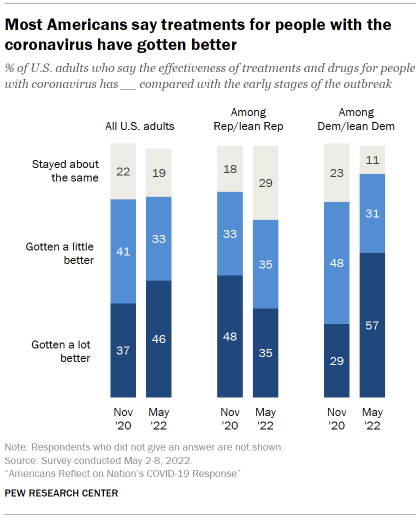
A majority of Americans think treatments and drugs for those with the coronavirus have gotten a lot (46%) or a little (33%) better since the early stages of the outbreak. The share who say they have gotten a lot better is up 9 points from 37% in November of 2020, when this question was last asked.
Democrats and Democratic leaners are now more likely than Republicans and Republican leaners to say the effectiveness of treatments for the coronavirus has gotten a lot better (57% vs. 35%) since the early stages of the outbreak.
Democrats’ views about the improvement of medical treatments for COVID-19 have become more positive since November 2020, during the last months of the Trump administration. By contrast, Republicans are less likely today to say medical treatments have improved over the course of the outbreak than they were in November 2020.
Vaccination rates, personal experiences with COVID-19 and testing
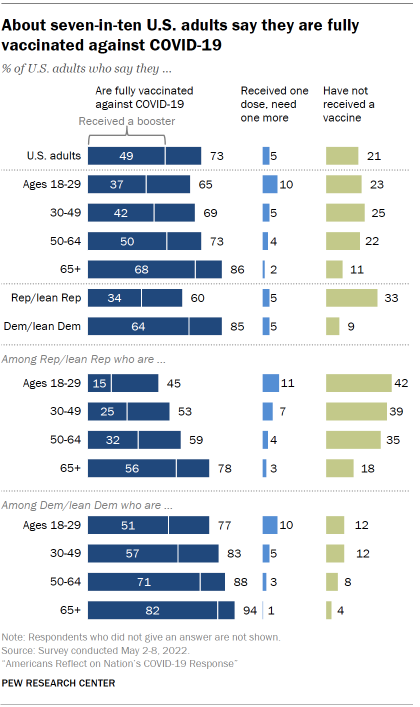
Overall, 73% of U.S. adults say they are fully vaccinated for coronavirus as of May 2022. This share is the same as it was in a January 2022 Pew Research Center survey. According to the Centers for Disease Control and Prevention (CDC), “fully vaccinated” means having received two doses of Pfizer or Moderna vaccines or one dose of the Johnson & Johnson.
A relatively small share of U.S. adults say they have received one dose of a vaccine but need one more (5%); 21% say they have not received a vaccine for COVID-19. Both shares are virtually unchanged from January 2022.
Republicans and Republican-leaning independents (60%) continue to be less likely than Democrats and Democratic leaners (85%) to say they are fully vaccinated.
Older adults also continue to be more likely than younger adults to say they are fully vaccinated, a pattern that holds true within each party.
As in the past, those who live in urban or suburban communities (76% each) are more likely than those living in rural areas (64%) to say they are fully vaccinated.
When it comes to booster shots, about half (49%) of the public say they are fully vaccinated and have received a booster shot within the past six months. The share is about the same as it was in January 2022.
Differences by partisanship persist in both the shares who say they are fully vaccinated and in the shares who say they’ve received a booster shot among fully vaccinated adults. A narrow majority of fully vaccinated Republicans (56%) have received a booster shot. This group makes up 34% of all Republicans. Meanwhile, a larger majority (75%) of fully vaccinated Democrats – or 64% of all Democrats – say they have received a booster shot.
Among both partisan groups, younger adults who are fully vaccinated remain less likely than older adults who are fully vaccinated to say they have received a COVID-19 booster shot.
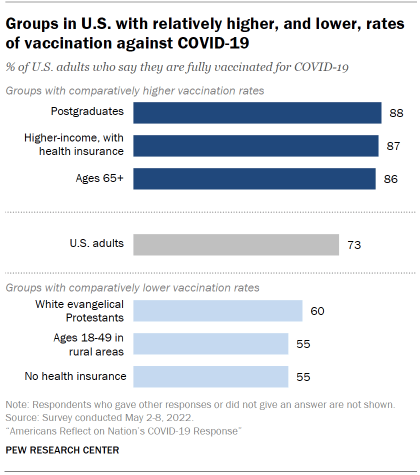
With vaccination rates among U.S. adults leveling off in recent months, differences across groups in the country have crystalized.
Looking across a wide range of characteristics associated with the decision to get a vaccine, some of those most likely to be fully vaccinated in the U.S. include those with a postgraduate degree, those in higher-income households with health insurance, and Americans ages 65 and older.
At the other end of the spectrum, those relatively less likely to be fully vaccinated include White evangelical Protestants, adults younger than 50 living in rural areas, and those without health insurance. See the Appendix for more details about vaccination rates across groups.
When it comes to personal experiences with the coronavirus, 46% of U.S. adults say they have tested positive for COVID-19 or been pretty sure they have had it.
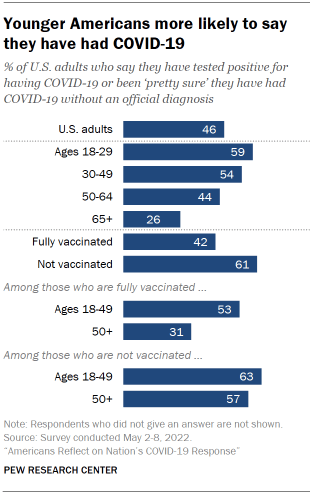
The share of Americans who say they have had COVID-19 has risen since August 2021, when three-in-ten (30%) said this.
Across age groups, younger adults are more likely than older adults to say they have tested positive for COVID-19 or been pretty sure they had it. A majority (59%) of adults ages 18 to 29 say this, compared with 26% of adults 65 and older.
Those who are fully vaccinated (42%) are less likely to say they have had COVID-19 than those who are not vaccinated (61%). (The survey did not ask respondents whether they got COVID-19 before or after being vaccinated.)
Among those who are fully vaccinated, younger adults are more likely than older adults to say they have had COVID-19.
When vaccination status and exposure to COVID-19 are taken together, 90% of Americans report some level of immune response to COVID-19 (78% have received at least one dose of a vaccine and an additional 12% are not vaccinated but say they’ve had the coronavirus). Public health experts are continuing to evaluate how long immunity from vaccination or previous infection last as coronavirus variants evolve.
Use of at-home testing is highest among young adults
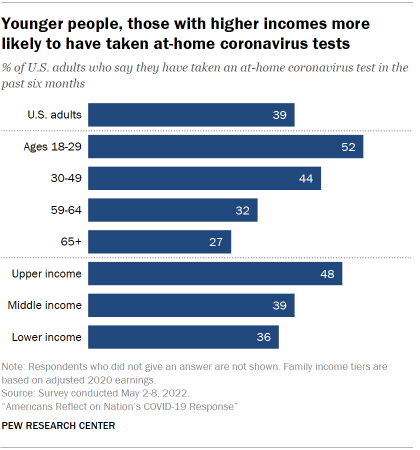
The CDC recommends the use of at-home coronavirus tests as one way for Americans to help reduce the spread of COVID-19.
About four-in-ten U.S. adults (39%) say they have taken an at-home COVID-19 test in the past six months.
Across age groups, younger adults are more likely to say that they have taken an at-home coronavirus test in the past six months. Around half (52%) of adults ages 18 to 29 say this, compared with 27% of those 65 and older.
Upper-income adults (48%) are more likely than middle-income (39%) or lower-income (36%) adults to say that they have taken an at-home COVID-19 test in the past six months.
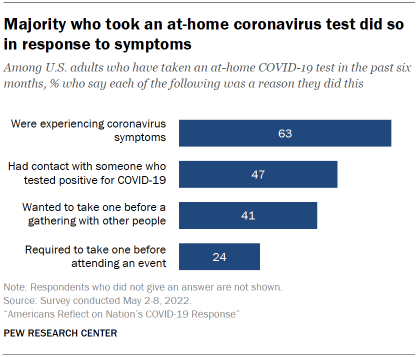
When the 39% of Americans who have taken an at-home COVID-19 test in the past six months were asked about their reasons for doing so, a majority of this group (63%) say that a reason was that they were experiencing coronavirus symptoms.
Around four-in-ten or more say that a reason they had taken an at-home COVID-19 test was that they had contact with someone who tested positive (47%) or wanted to take one before attending a gathering with other people (41%).
About a quarter (24%) say that a reason they have taken an at-home COVID-19 test was that they were required to do so before an event.
For each of the possible reasons listed for taking a COVID-19 test, younger adults are generally more likely than older adults to say that each had been a factor. For example, 57% of adults ages 18 to 29 say that having contact with someone who tested positive for COVID-19 was a reason they had done an at-home test, compared with 37% of adults 65 and older.
Personal concern over virus lower than earlier in the outbreak
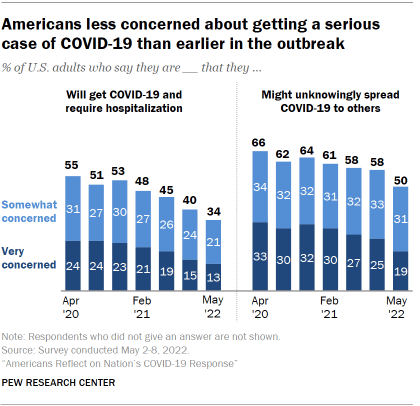
About a third of Americans (34%) say they are at least somewhat concerned that they will get COVID-19 and require hospitalization, a much smaller share than said this at earlier stages of the outbreak.
Half of Americans say they are at least somewhat concerned that they might unknowingly spread COVID-19 to others. This share has declined steadily since November 2020, when about two-thirds (64%) of U.S. adults said this.
Consistent with these declines, Americans are also less likely to see the coronavirus outbreak as a major threat to their personal health than at earlier stages of the outbreak. About a quarter (23%) now say this, down from 30% in January 2022. See the Appendix for more details.
